Parents have hailed the unbreakable bond between their identical baby twins, saying that cuddles from his brother are helping their premature son who was born weighing 1lb to thrive.
Chester Graves was born prematurely at 28 weeks on 15 July this year weighing just 1lb 1oz, alongisde his brother Otis who was three times the size at 3lb 7oz.
After six weeks Otis was discharged and now weighs 6lb 3oz, but tiny Chester has fought for his life since his birth and still now only weighs 3lb 6oz.
Doting parents, Kelly Graves, 32, and husband, Billy, 35, from Benfleet, Essex, say they have no doubt that Chester’s miraculous fight for survival is down to the bond he shares with his identical twin, Otis.
‘I have no doubt that cuddles with his twin has helped him keep fighting,’ Kelly said.
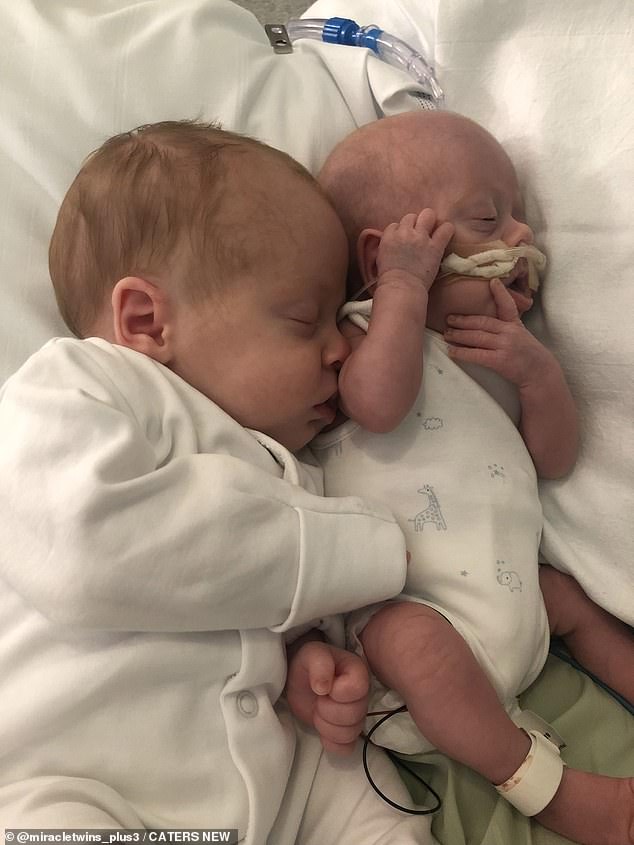
Otis Graves cuddling his brother Chester in hospital. The identical twins were both born prematurely at 28 weeks on 15 July this year, but Chester was much smaller due to Selective Intrauterine Growth Restriction
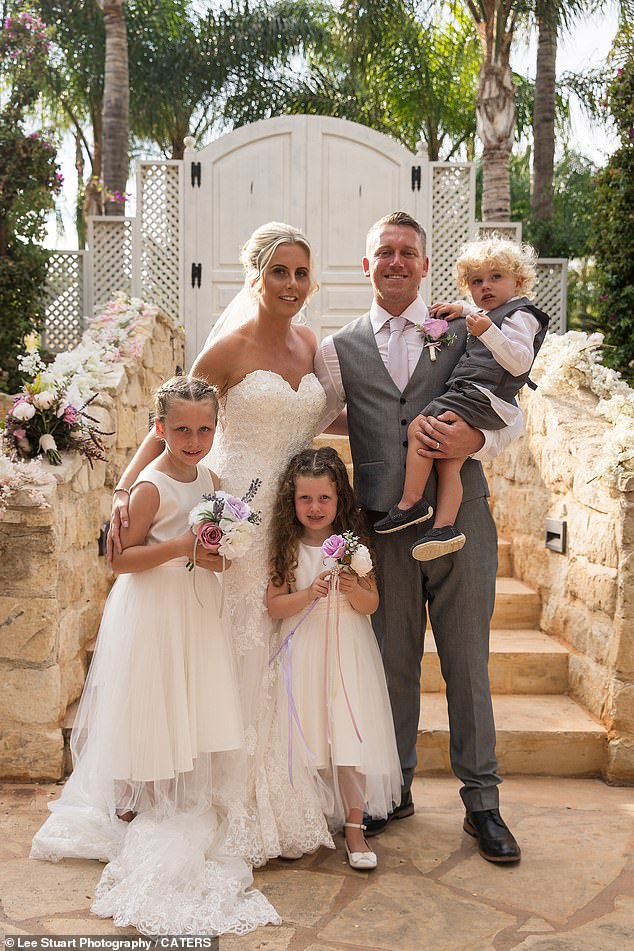
A family photo at Kelly and Billy’s wedding. In addition to the twins, the couple have three older children (left to right) Phoebe, Florence and Albert
‘The twins finally met for the first time since being born on September 22, which was incredibly emotional.
‘It was everything I was waiting for, and although Otis was asleep, Chester was obsessed with him and couldn’t take his eyes away from his brother.
Touching photos show the pair lying side by side during family visits to Chester in the neonatal unit at Southend Hospital, where he will likely remain for another two months.
Kelly said: ‘Since the day my waters broke at 28 weeks we’ve lived in a whirlwind.
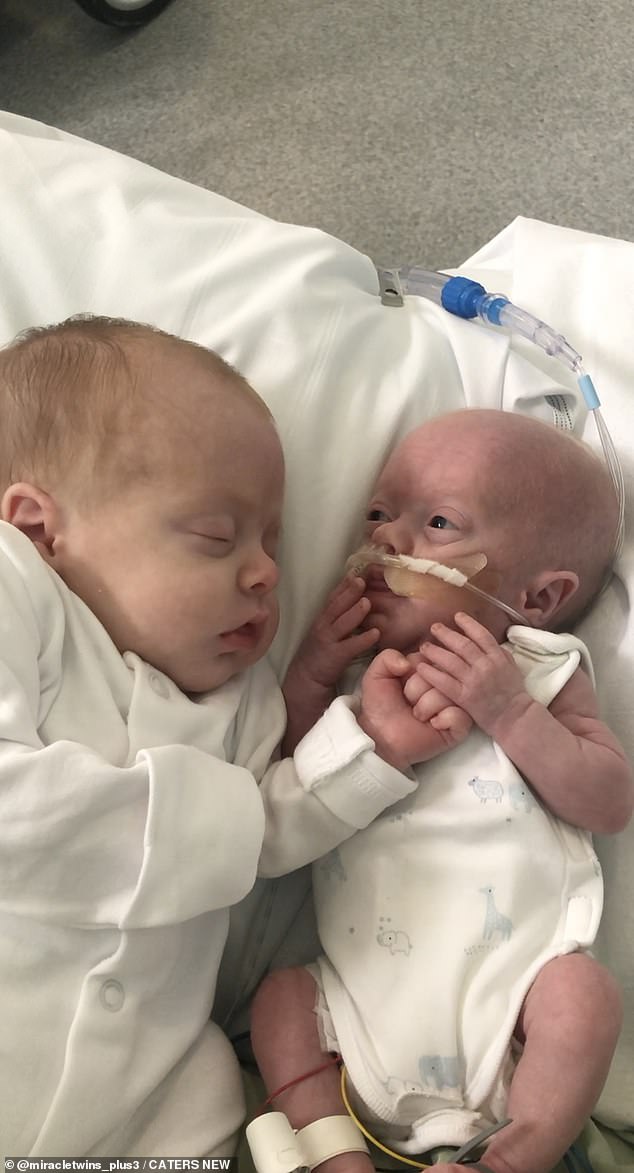
Doting parents say they have no doubt that Chester’s miraculous fight for survival is down to the bond he shares with his identical twin
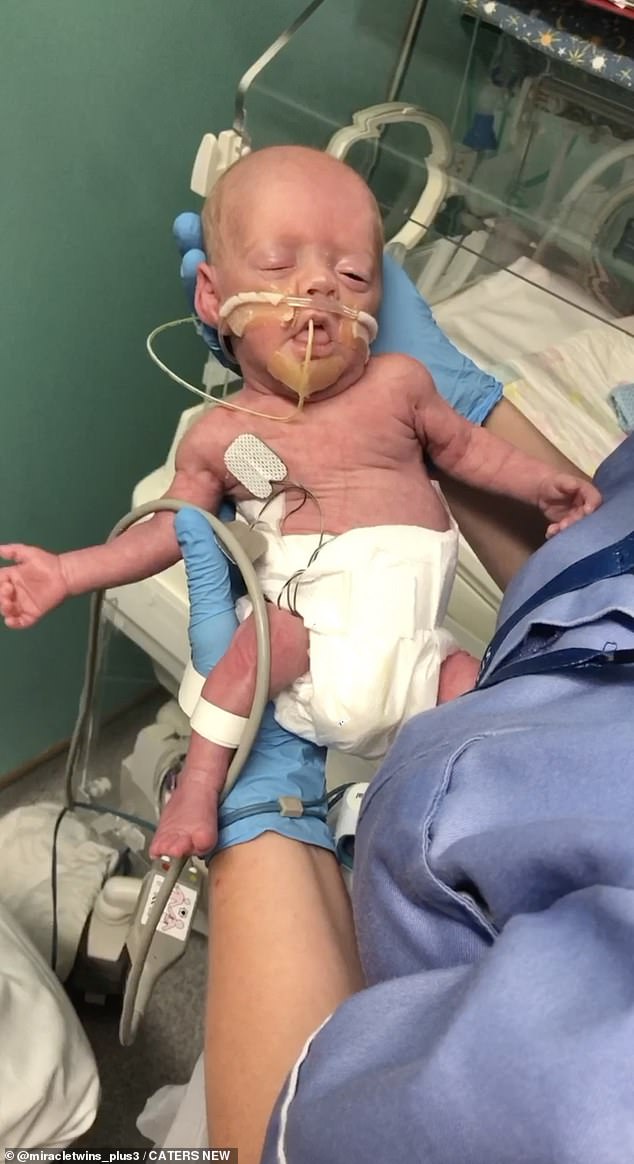
The difference in size between the two brothers was due to a condition called Selective Intrauterine Growth Restriction
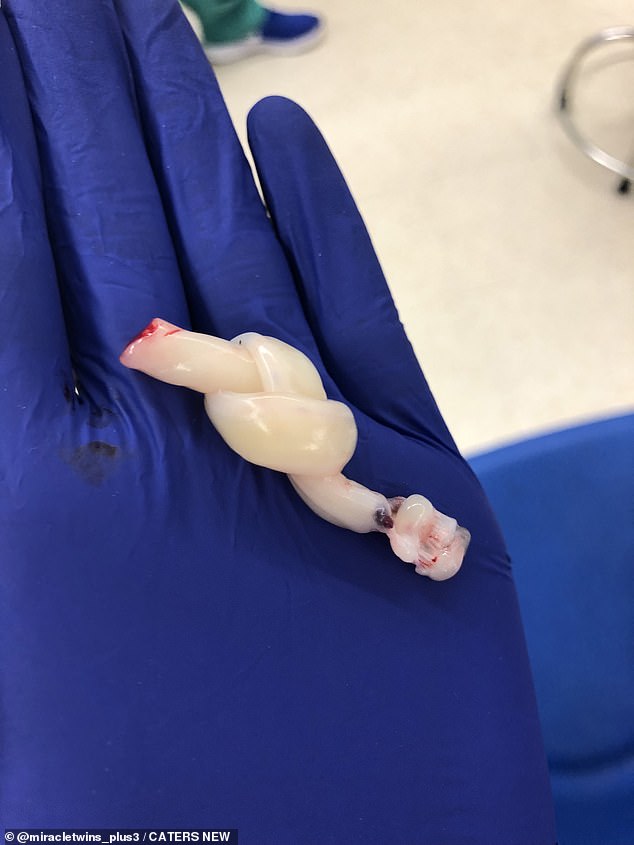
Chester’s health problems first became apparent at Kelly’s 16-week scan, where she was informed the babies differed in size by 25 per cent – something that concerned the doctors.
‘But we are so lucky that Chester is a fighter and despite everything he has been through, he is still fighting in order to come home and be with his parents, Otis and the rest of the family.
‘He is still being incubated and kept on high flow oxygen since being transferred back to our local hospital in Southend.’
‘We cannot wait to finally get Chester home. We are hoping to bring him back in November.’
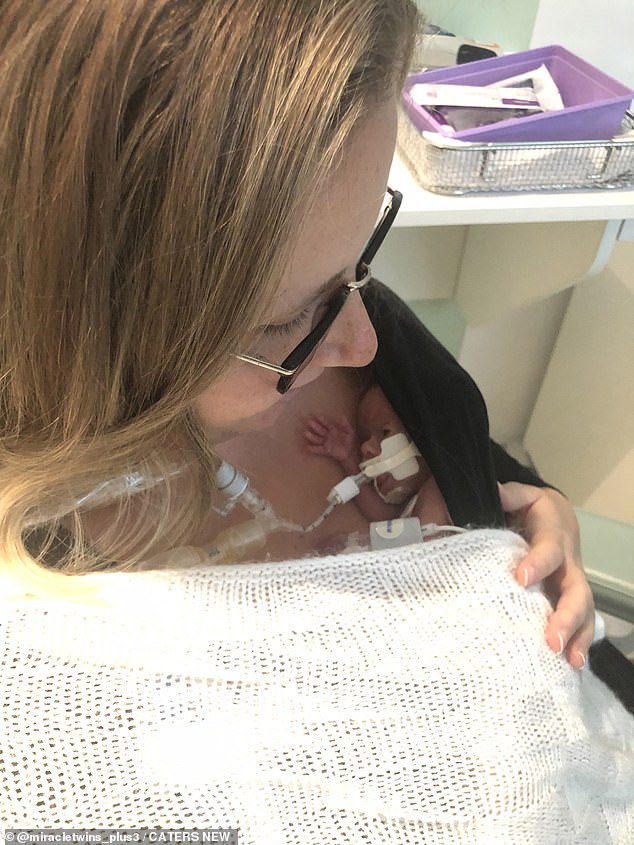
Chester, inside of Kelly’s cardigan. Chester didn’t receive the required nutrients from the placenta, halting his growth
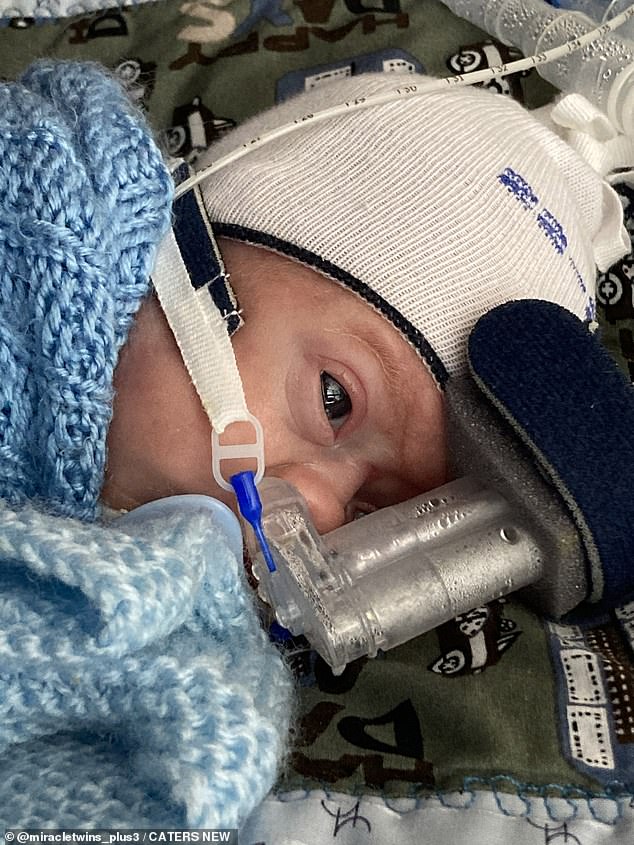
At 19 weeks, Kelly was admitted to the Kings College Hospital in London for laser surgical treatment. Pictured: Baby Otis receiving Oxygen at 8 weeks old
Chester’s health problems first became apparent at Kelly’s 16-week scan, where she was informed the babies differed in size by 25 per cent – something that concerned the doctors.
The difference in size between the two brothers was due to a condition called Selective Intrauterine Growth Restriction, which results in Chester not receiving the required nutrients from the placenta, halting his growth.
At 19 weeks, she was admitted to the Kings College Hospital in London for laser surgical treatment
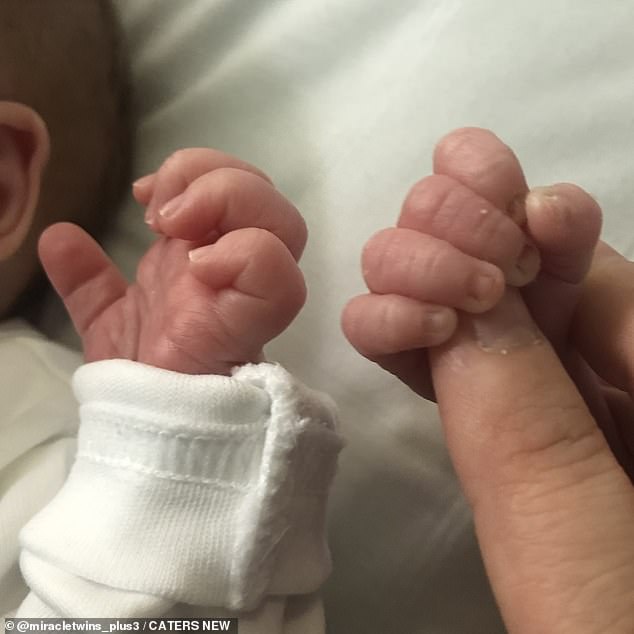
After the surgery, Kelly and Billy were told Chester was still only growing around 25g a week, whereas Otis was growing roughly 100g a week. Chester holding Kelly’s finger

Chester following his birth. Kelly was being told at every scan that her infant son may not survive
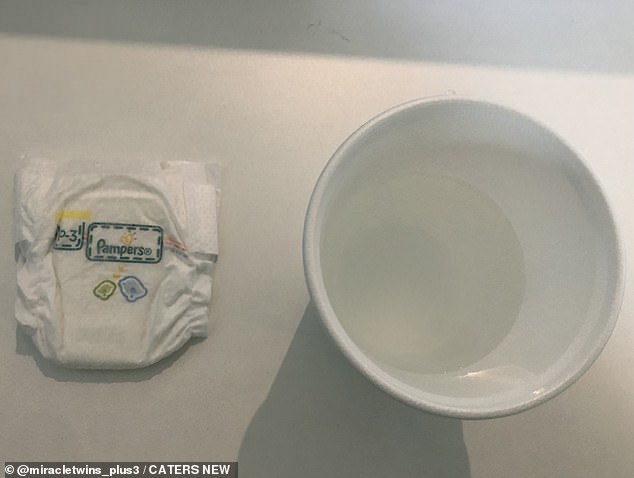
Chester’s nappy next to a hospital styrofoam cup. He was born weighing only 1lb due to complications
She explained: ‘They informed us that there was absent flow of nutrients to Chester was the reason why he wasn’t really growing.
‘I had to have endoscopic laser surgery whereby they enter the womb through the side of your body in order to reach the placenta kill of the blood vessels connecting the two babies.
‘The surgery was performed to separate the babies in the womb so that if Chester hadn’t survived it would have protected Otis from dying or being left with lasting brain damage.’

A C-section was performed, and Otis was immediately ventilated, but Chester had to first be stabilised as he had become very weak during the birth

L-R Albert, Florence and Phoebe excited about the news of the twins. Meanwhile Kelly was eating around 200g of protein per day to help him grow and was drinking around five litres of water
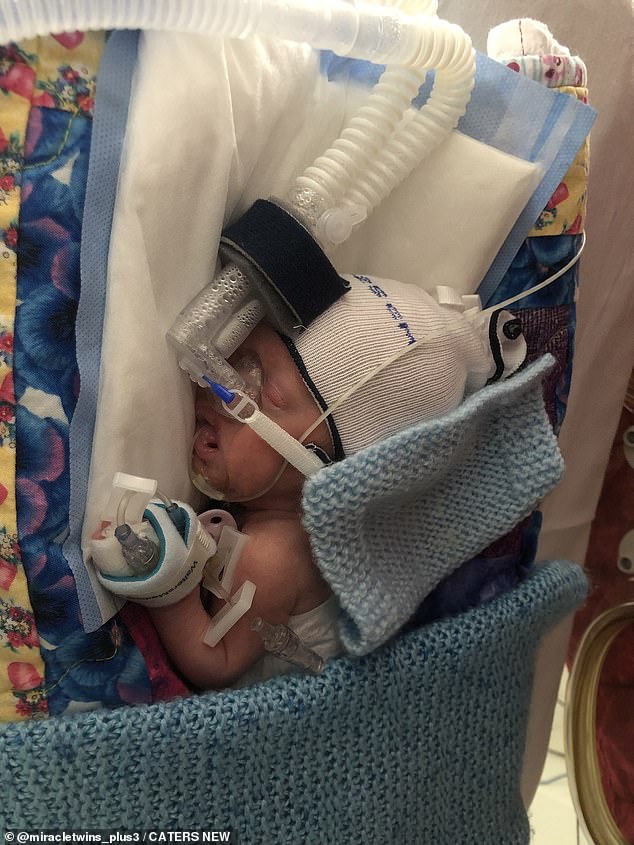
Baby Otis reciving oxygen at 8 weeks old. Kelly was told Chester’s heart rate kept dipping and that the chances of survival from the caesarean would be low
After the surgery, Kelly and Billy were told Chester was still only growing around 25g a week, whereas Otis was growing roughly 100g a week.
She added: ‘I was being told at every scan that he may not survive which was heart-breaking.
‘I went away and was eating around 200g of protein per day to help him grow and was drinking around five litres of water to try and get Chester’s water levels up because they were also low.
‘This was not in any way proven to help, but I tried everything I could to replenish his levels and keep him fighting.’
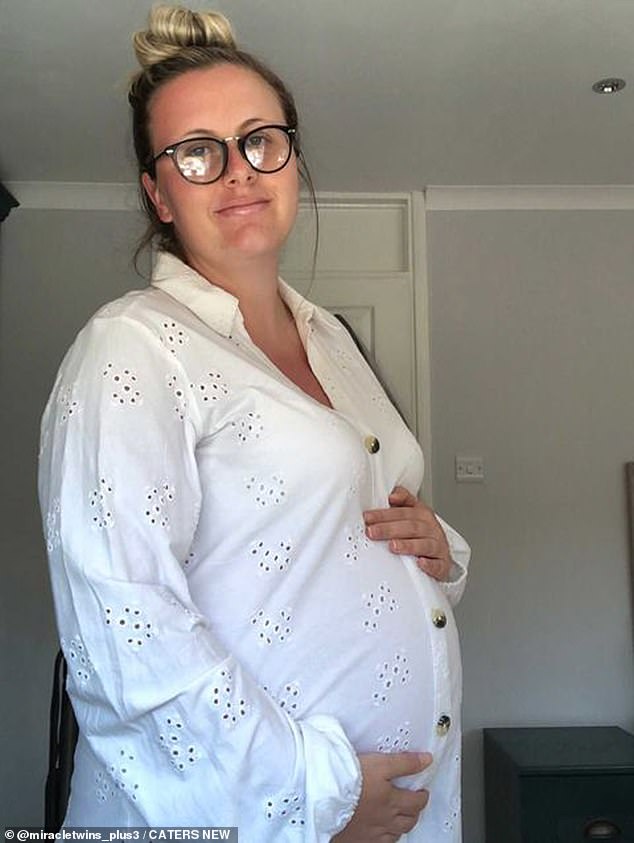
Kelly during her pregnancy. A C-section was performed, and Otis was immediately ventilated, but Chester had to first be stabilised as he had become very weak during the birth
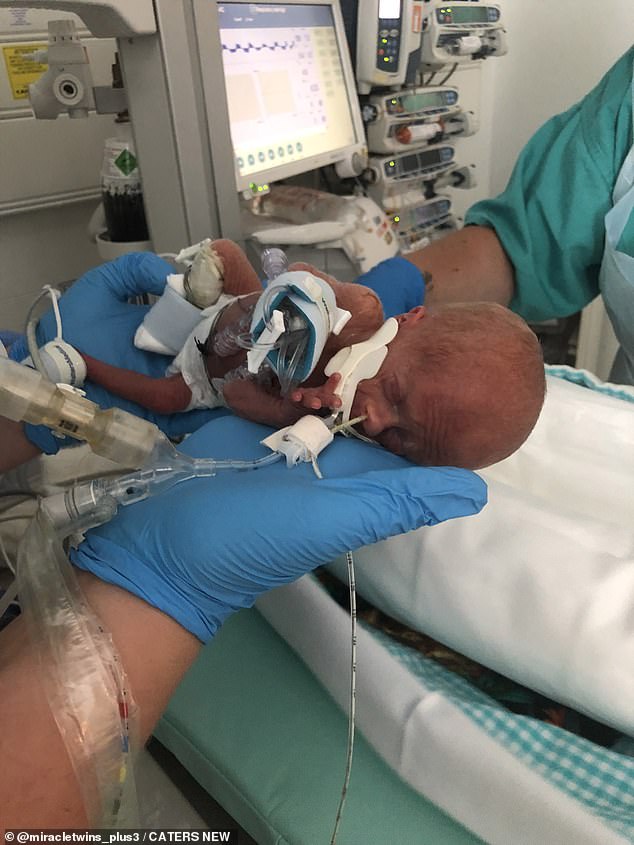
Prematrue Chester at 2 weeks in the hospital. When Chester came out, they found a knot in his cord which also halted his growth
Chester’s condition stabilised but at 28 weeks, Kelly’s Waters broke, and she was blue lighted to go to Addenbrooke’s Hospital in Cambridge.
She explained: ‘At this point Chester was 485 grams which was close to being deemed viable, but we were told his heart rate kept dipping and that the chances of survival from the caesarean would be low.
‘We just had to hope that he would keep fighting.’
A C-section was performed, and Otis was immediately ventilated, but Chester had to first be stabilised as he had become very weak during the birth.
Kelly added: ‘Otis came out first and he was put into the incubator.
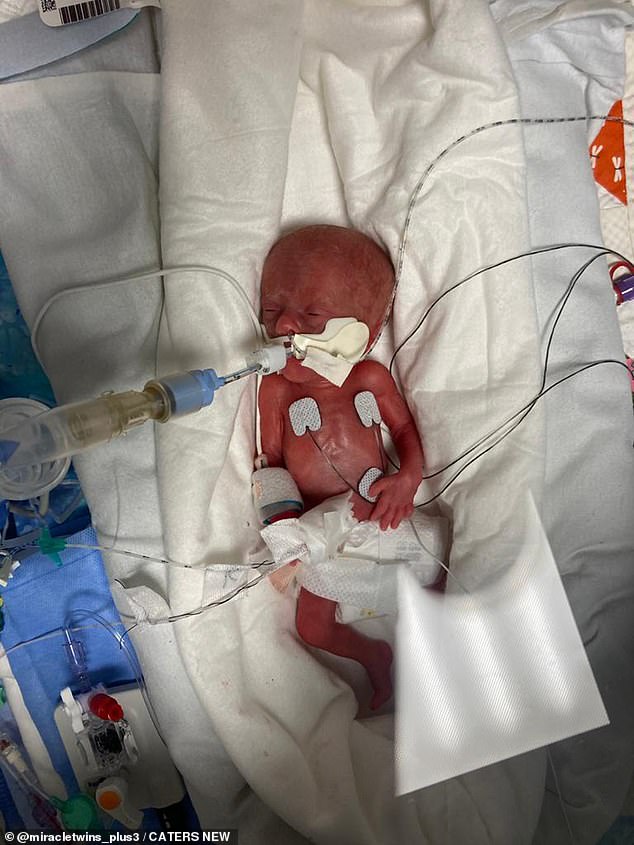
Tiny Chester has fought for his life since his birth and still now only weighs 3lb 6oz. He also had a hole in his heart which was discovered afterwards which has now closed
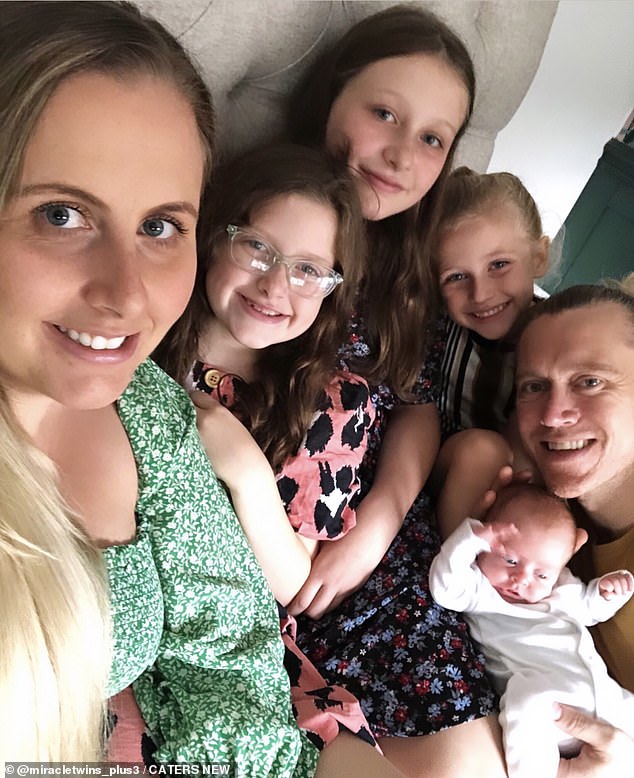
The couple are also parents to Phoebe, 10, Florence, 8 and Albert, five, who the couple have said all been incredibly supportive.
‘When Chester came out, they found a knot in his cord which also halted his growth, and the consultant was desperate to get him incubated as soon as possible to help him survive.
‘Thankfully they were able to ventilate him and ever since he has been fighting multiple issues such as Necrotising Enterocolitis, or NEC, which is a serious condition where tissue in the bowel becomes inflamed which Chester caught after nine days.
‘He also had a hole in his heart which was discovered afterwards which has now thankfully closed and also eye surgery.’
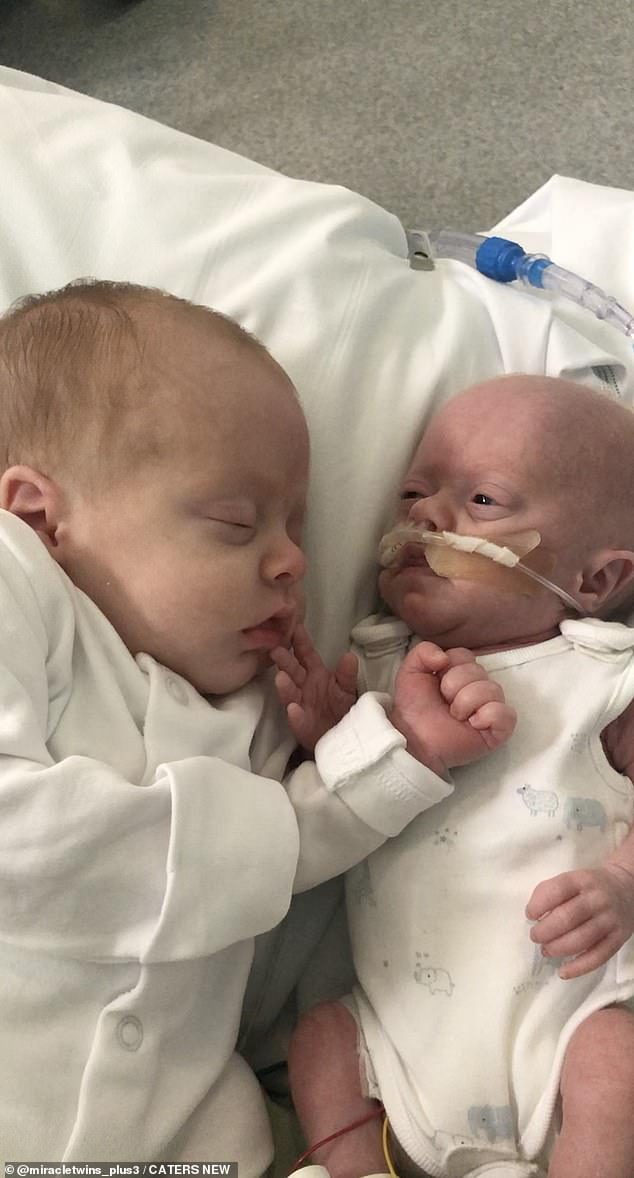
People kept asking the family they did it, but they had no choice, they said they went into survival mode and just kept going
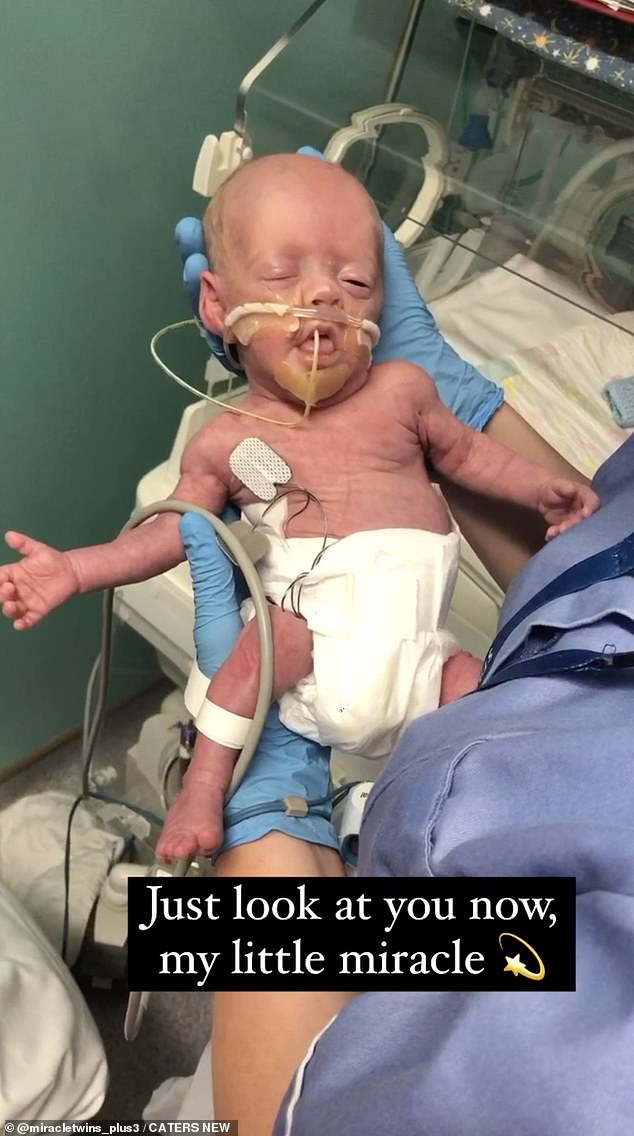
Chester being held in the hospital. Chester’s life clung in the balance as he weighed just 1lb 1oz compared to his brother who weighed 3lb 7oz
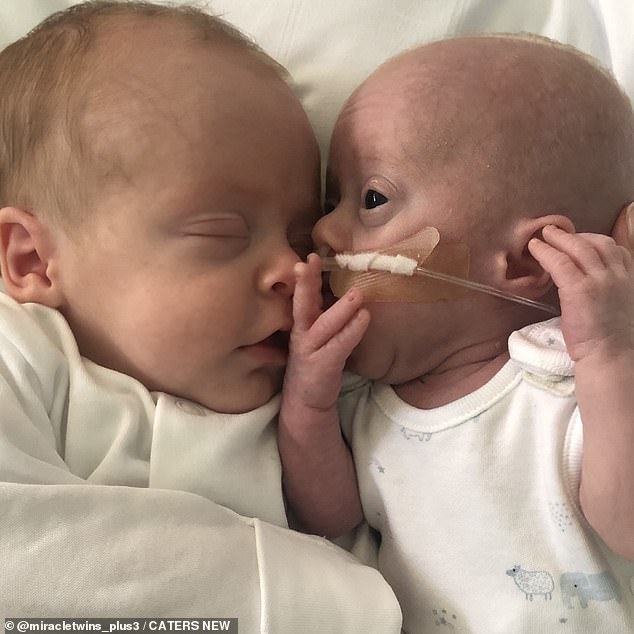
L-R Twins Otis and Chester. The family say they have no doubt that Otis’s miraculous fight for survival is down to cuddles with his identical twin
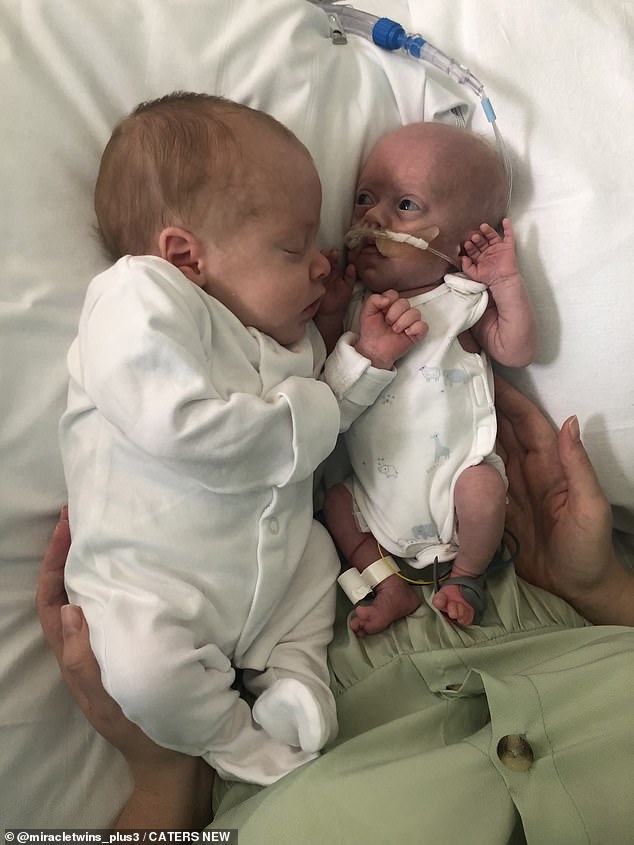
L-R Twins Otis and Chester. After six weeks Otis was discharged and now weighs 6lb 3oz
TYPES OF SIUGR SELECTIVE INTRAUTERINE GROWTH RESTRICTION (SIUGR)
sIUGR has been classified into three types based on specific blood flow patterns in the umbilical artery of the growth-restricted twin.
Type 1
Consistent forward flow in the umbilical artery of the growth-restricted twin
Average age at delivery is 34-35 weeks gestation
Type 2
Either persistent absent blood flow or persistent reversal of blood flow in the umbilical artery of the growth-restricted twin
Average age at delivery is 26-28 weeks gestation
Type 3
Unpredictable pattern of intermittent blood flow in the umbilical artery of the growth-restricted twin (forward, absent and reversed)
Average age at delivery is 30 weeks gestation
In up to 15 percent of cases, the growth-restricted twin may not survive, which can also impact the neurodevelopment of the normally growing twin
Advertisement
Kelly and Billy were able to bring Otis home after 46 days spent between Addenbrooke Hospital and their local hospital of Southend, but Chester has had to stay put on high flow oxygen and incubation.
She explained: ‘At first, every day we were driving from Cambridge to Southend to visit both babies, and then back to home to visit my other kids which took around three and a half hours.
‘People kept asking how we did it, but we had no choice, we went into survival mode and just kept going.’
‘The worst thing was that this was all happening over the school holidays, so we were barely able to spend any time with the kids who had to stay with other family members’.
The couple are also parents to Phoebe, 10, Florence, 8 and Albert, five, who the couple have said all been incredibly supportive.
Kelly added, ‘The kids have been incredible, they are so young but are just as desperate to get Chester home as they haven’t been able to even really meet him yet due to covid.’
Chester was able to be transferred to Southend Hospital, where Kelly visits him every day.
She said: ‘It is very bittersweet because we have Otis at home now and everyone says how nice it must be, but it’s also horrible because we can’t feel complete until both babies are back together.
Chester has now tripled his birth weight, currently weighing 3lb 6oz, and Kelly and Billy are desperate to get him home.
She added: ‘ He has to gain a further 255 grams still and will most likely be on low flow oxygen when he’s home, but we are hoping in around a month or two he can finally meet the rest of the family.’
To read more, visit @miracletwins_plus3 on Instagram.
Source link : https://www.dailymail.co.uk/femail/article-10060245/Parents-hailed-recovery-1lb-baby-unbreakable-bond-twin-brother.html











